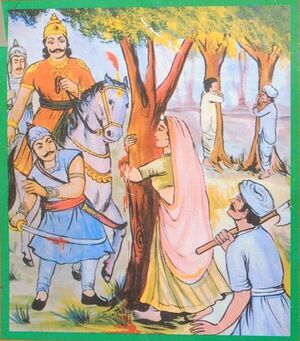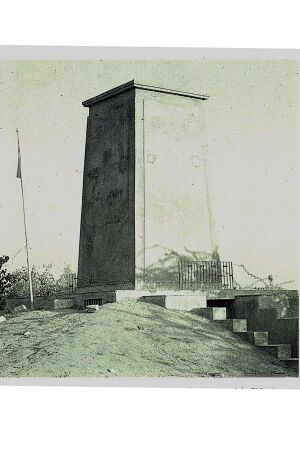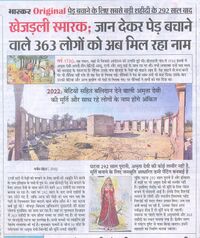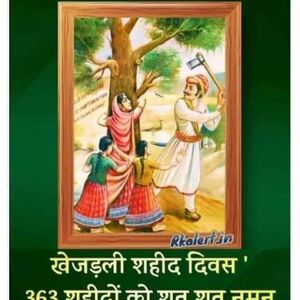Amrita Devi
| Author: Laxman Burdak, IFS (R). |

Amrita Devi (Beniwal) sacrificed her life along with her three daughters viz. Asu, Ratni and Bhagu in year 1730 to save green trees being felled by the Maharaja of Jodhpur at a place known as Khejarli in Marwar, Rajasthan. Along with her more than 363 other Bishnois, died saving the Khejri trees.
Khejadli village Jodhpur district
Khejarli or Khejadli is a village in Jodhpur district of Rajasthan, India. The name of the town is derived from Khejri (Prosopis cineraria) trees, which were in abundance in the village. In this village 363 Bishnois had to sacrifice their lives in 1730 AD for protecting green trees.
Beginning of the Chipko ---Save Trees-- movement

It is the place where Chipko movement originated in India. It was a Tuesday, black Tuesday in Khejadli. 10th day of the bright fortnight of the month Bhadra (Indian lunar Calendar) in 1730 A.D. Amrita Devi a mother of three daughters viz. Asu, Ratni and Bhagu bai was at home with her daughters. Suddenly, she came to know that many people had descended in their otherwise sleepy village. It was a party of Maharaja Abhay Singh, Ruler of Marwar (Jodhpur) state who wanted to fell green Khejri (Prosopis cineraria) trees to burn lime for the construction of his new palace. Since there was a lot of greenery in the Bishnoi villages even in the middle of Thar Desert, the king ordered his men to get the woods from Khejri trees.
Amrita Devi sacrificed for saving trees
Amrita Devi protested against King's men attempting to cut green trees as it was prohibited in Bishnoi religion. The malevolent feudal party told her that if she wanted the trees to be spared, she should give them money as bribe. She refused to acknowledge this demand and told them that she would consider it as an act of ignominy and insult to her religious faith. She said that she would rather give away her life to save the green trees. It is at that stage she spoke these words:
- "Sar sāntey rūkh rahe to bhī sasto jān" (सर सान्टे रूख रहे तो भी सस्तो जाण)
Meaning: If a tree is saved even at the cost of one's head, it's worth it.
Saying these words, she offered her head! The axes, which were brought to cut the trees, severed her head from her trunk. The three young girls Asu, Ratni and Bhagu were not daunted, and offered their heads too!!
The news spread like wildfire. Bishnois gathered and sent summons to 83 Bishnoi villages to come and decide on the next course of action. Since the supreme sacrifice by those four had not satisfied the royal party, and the felling of green trees was continued, it was decided that for every green tree to be cut, one Bishnoi volunteer would sacrifice his/ her life. In the beginning, old people voluntarily started holding the trees to be cut in an embrace as in the Chipko movement of 20th Century in Uttar Pradesh (India).
363 Bishnois became martyrs

In this way many valiant old persons gave away their lives, but it failed to have the desired impact. Moreover, the Hakim (Royal party's leader) taunted the Bishnois that in this manner they were offering unwanted old persons. Soon, young men, women, including recently married ones and children were sacrificing themselves in a similar manner.
There was intense pandemonium. It completely shook the tree-felling party, headed by their leader Girdhar Das Bhandari (Hakim), they left for Jodhpur with their mission unfulfilled and told the Maharaja about what had happened. As soon as he learnt it, he ordered stoppage of the felling of trees.
By that time, Three Hundred and Sixty Three (363) Bishnois, young and old, men and women, married and unmarried, rich and poor had already become martyrs. Gotra wise number of these martyrs was as under: Achra (1), Badaderi (1), Badiyani (1), Chotiya (1), Degipal (1), Dudan (1), Geela (1), Goyal (1), Janwar (1), Jewlia (1), Jhuria (1), Kalirani (1), Khavi (1), Khichar (1), Kupasiya (1), Lamba (1), Maal (1), Ranwa (1), Sigar (1), Tandi (1), Vasu (1), Adina (2), Bhadiawas (2), Bola (2), Jhangu (2), Manju (2), Punia (2), Thalod (2), Bhanwala (3), Burdak (3), Chahar (3), Dhatarwal (3), Potalia (3), Rahad (3), Siyol (3), Bhadia (4), Dhayal (4), Isram (4), Karhwasra (4), Bhangarwas (5), Dukiya (5), Khava (6), Khileri (6), Lol (6), Nain (6), Sahu (6), Sinwar (6), Dhaka (8), Dara (9), Dudi (10), Kaswan (10), Khod (10), Khokhar (10), Panwar (10), Asiagh (13), Not clear (22), Jani (15), Saran (18), Babal (22), Beniwal (25), Bhadu (26), Godara (37)
Note: Read above Gotras as under: Badaderi भडाडरा, Badiyani भड़िया, Degipal डिगिवाल, Dudan डूडी, Khavi = खावा, Bhadiawas = भडि़यासा, Bhanwala = भांवला, Bhangarwas = भंगरवा, Sinwar = सींवर, Khava = खावा
Amrita Devi Vishnoi Award
The Government of Rajasthan and Madhya Pradesh, Department of Forest, have started the prestigious state level Amrita Devi Vishnoi Smriti Award for excellent contribution to the protection and conservation of wild animals. Award consists of cash Rs 25000/- and a prashasti.
Recipients of Amrita Devi Vishnoi Award
- Late Shri Ramnarayan Karwasra (रामनारायण कड़वासरा) was the winner of Amrita Devi Vishnoi Smriti Award 1999 for protecting wild animals. Awarded by Rajasthan Government.
खेजड़ली स्मारक

सन् 1730 में जोधपुर के महाराजा ने अपने सैनिकों को राजकार्य हेतु वृक्ष काट कर लाने के लिए कहा। खेजड़ली गाँव में खेजड़ी के वृक्षों की अधिकता थी, इसलिए सैनिकों ने इसी गाँव में जाकर वृक्ष काटने का निर्णय लिया। उस दिन खेजड़ली गाँव में लगभग 383 लोगों का बलिदान हुआ। ये सभी बलिदानी जम्भेश्वर के अनुयायी थे।
सन 1730 में राजस्थान के मारवाड़ में खेजड़ली नामक स्थान पर जोधपुर के महाराजा द्वारा हरे पेड़ों को काटने से बचाने के लिए, अमृता देवी बेनीवाल ने अपनी तीन बेटियों आसू , रत्नी और भागू के साथ अपने प्राण त्याग दिए। उसके साथ 363 से अधिक अन्य बिश्नोई , खेजड़ी के पेड़ों को बचाने के लिए मर गए।
खेजड़ली गाँव जिला जोधपुर: खेझरली या खेजड़ली भारत के राजस्थान के जोधपुर जिले का एक गाँव है। कस्बे का नाम खेड़ी (प्रोसोपिस सिनारिया) पेड़ों से लिया गया है, जो गाँव में बहुतायत में थे। इस गाँव में 363 बिश्नोईयों को 1730 ई. में हरे पेड़ों की रक्षा के लिए अपने प्राणों की आहुति देनी पड़ी थी।
चिपको की शुरुआत – पेड़ बचाओ आंदोलन: यह वह स्थान है जहाँ चिपको आंदोलन की उत्पत्ति भारत में हुई थी। वह मंगलवार का दिन था, काला मंगलवार खेजड़ली गाँव के लिए। 1730 ईसवी में भद्रा महीने (भारतीय चंद्र कैलेंडर) के 10 वें उज्ज्वल पखवाड़े के दिन अमृता देवी अपनी तीन बेटियों आसू, रत्नी और भागू बाई के साथ घर पर थीं। तभी अचानक उन्हें पता चला की मारवाड़ जोधपुर के महाराजा अभय सिंह के सैनिक उनके गांव खेजड़ी के पेड़ों को काटने आयें है।
खेजड़ी के पेड़ों की लकड़ियों का इस्तेमाल महाराजा अभय सिंह अपने नए महल के निर्माण में करना चाहते थे। थार रेगिस्तान में होने के बाद भी बिश्नोई गांवों में बहुत हरियाली थी और खेजड़ी के पेेेड़ बहुतायत में थे। इसलिए महाराजा अभय सिंह ने अपने आदमियों को खेजड़ी के पेड़ों से लकड़ियाँ प्राप्त करने का आदेश दिया था।
अमृता देवी ने राजा के सैनिकों के खिलाफ विरोध प्रदर्शन किया, क्योंकि बिश्नोई धर्म में हरे पेड़ों को काटना मना है। इसलिए अमृता देवी ने पेड़ों को बचाने के लिए अपनी जान भी देनो को तैयार थीं। उन्होंने कहा कि–
- सिर साटे, रूंख रहे, तो भी सस्तो जांण।अम्रता देवी पेड़ों को बचाने के लिए
जिसका अर्थ है कि – “यदि किसी व्यक्ति की जान की कीमत पर भी एक पेड़ बचाया जाता है, तो वह सही है।”
अमृतस्य पुत्री : अमृतादेवी

लेखक: - दयाराम महरिया, कूदन (सीकर)
मारवाड़ रियासत में सन् 1730 में अभयसिंह शासन कर रहे थे ।उनको महल बनाने के लिए चुना पकाने के लिए लकड़ियों की आवश्यकता थी। उन्होंने रियासत के हाकिम गिरधारी दास भंडारी के नेतृत्व में कार्मिकों को खेजड़ी काट कर लाने के लिए भेजा । खेजड़ली गांव में जैसा कि इसके नाम से ही विदित है खेजड़ियां खूब थी । वह बिश्नोई बहुल गांव था ।जाम्भो जी के अनुयाई बिश्नोई प्रकृति प्रेमी होते हैं तथा प्रकृति की रक्षा के लिए 29 नियमों का पालन करते हैं ।उस जमाने में गिनती 20 तक ही आती थी इसलिए 20+9=29 अर्थात् बिश्नोई कहलाए। रियासत के कार्मिकों ने जब खेजड़ी का पेड़ काटना चाहा तो सर्वप्रथम अमृता देवी बिश्नोई ने इसका विरोध किया परन्तु कार्मिकों के नहीं मानने पर वह खेजड़ी के पेड़ से लिपट गई और कहा 'सिर साटै रूंख रहे तो भी सस्तो जाण' अर्थात् सिर के बदले पेड़ रहता है तो भी सस्ता जानो । पेड़ के साथ अमृतादेवी बिश्नोई बलिदान हो गई । ।अमृतादेवी के बाद उनसे प्रेरित होकर उनकी तीनों लड़कियां आसू,भागू और रत्नी भी पेड़ों के साथ कट गई ।इस पर भी रियासत के कार्मिक नहीं माने । यह खबर जब आसपास के गांव में पहुंची तो बिश्नोई समाज के 83 गांवों के 363(69 महिला ,294 पुरुष )नर- नारी पेड़ों के साथ कटकर शहीद हो गए । विश्व के इतिहास में पेड़ों की रक्षा के लिए बलिदान का ऐसा उदाहरण अन्य देखने को नहीं मिलता ।
- तरु रक्षा बलिदान की, घटना जग विख्यात।
- मृत अमृत 'देवीअमृता ',त्रिशत त्रिसठ मनु साथ ।।
- बिश्नोई प्रेमी प्रकृति ,जीव-जड़ी रक्षान ।
- 'दयाराम 'शत -शत नमन, नरु अरु तरु बलिदान।।
हमारे शास्त्रों में कहा गया है- वयं अमृतस्य पुत्रा: अर्थात हम सब ईश्वर की संतान है । अमृतादेवी अमृत हैं।
आदरणीय श्री लक्ष्मणसिंह जी बुरड़क सेवानिवृत्त (आईएफएस) जाटलैंड वेबसाइट को संचालित करते हैं। वे सोशल मीडिया के माध्यम से समाज की अच्छी सेवा कर रहे हैं ।उनके द्वारा उपलब्ध करवाए गए 363 शहीदों का गोत्रवार विवरण निम्न अनुसार है ।गोत्र अंग्रेजी से हिंदी में लिखे गए हैं ।अतः लेखन में त्रुटि हो सकती है-
निम्न प्रत्येक गोत्र से एक: ऐचरा, भढ़ाडरा, चोटिया, डिगिपाल, डूडी , गिला, गोयल, जनवार,जेवलिया ,झूरिया, कालीरावणा, खावी, खीचड़ ,कूपासिया, लांबा, माल, रणवां ,सीगड़, टांडी वासु
निम्न प्रत्येक गोत्र से दो: अदीना,भड़ियासा, बोला, जांगू ,मांजू, पूनिया, थालोड़
निम्न प्रत्येक गोत्र से तीन: भनवाला, बुरड़क ,चाहर, धेतरवाल, पोटलिया ,राड़, सियोल
निम्न प्रत्येक गोत्र से चार: भड़िया,धायल, इसराण ,कड़वासरा
निम्न प्रत्येक गोत्र से पांच: बांगड़वा, डूकिया
निम्न प्रत्येक गोत्र से छह: खावा,खिलरी,लोल,नैन,साहू,सिंनवार, ढ़ाका, डारा
निम्न प्रत्येक गोत्र से दस: डूडी,कसवां,खोड,खोखर, पंवार,सिहाग,जाणी,सारण,बाबल,अस्पष्ट,बेनीवाल,भादू, गोदारा
Back to The Brave People/Back to The Martyrs

